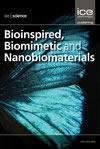煅烧羟基磷灰石-β-环糊精-亚甲基制备的高分散羟基磷灰石(HAp)粉末的化学稳定性blue@carbon
IF 0.6
4区 工程技术
Q4 ENGINEERING, BIOMEDICAL
引用次数: 0
摘要
生物相容性羟基磷灰石(HAp)粉末由于形成不可逆的聚集体而具有降低其表面积的热力学驱动趋势。为了应对这一挑战,本文通过传统的湿法沉淀方法制备了HAp杂化粉末,随后进行水热碳化以进行表面改性。测定了键合水红外峰与游离水红外峰的晶粒尺寸、晶粒度和面积比,以研究HAp结晶随工艺参数的变化。HAp的结晶是由柠檬酸盐、含氮亚甲基蓝(MB)、富含氢基团的β-环糊精(CD)和含氧有机碳壳形成的水分子在隐形层中富集的水促进的。低表面积导致通过煅烧HAp-CD-MB@C.酸性缓冲液的pH值在培养过程中缓慢增加HAp-CD-MB@C在550°C下煅烧2小时后具有化学稳定性和大晶粒度的粉末 h.本研究将阐明具有均匀尺寸分布、良好分散形态和调节化学稳定性的纳米无机粉末的制备,以及它们作为小分子物质载体和填料在复合材料中的潜在应用。本文章由计算机程序翻译,如有差异,请以英文原文为准。
Increased chemical stabilities of well-dispersed hydroxyapatite (HAp) powders prepared by calcination of HAp-β-cyclodextrin-methylene blue@carbon
Biocompatible hydroxyapatite (HAp) powders have thermodynamically driven tendencies to lower their surface areas due to the formation of irreversible aggregations. To address this challenge, HAp hybrid powders are herein prepared by a traditional wet-precipitation method with subsequent hydrothermal carbonization for surface modification. The crystallite size, crystallite degree and area ratio of the infrared peak assigned to bonding water versus that of free water are determined to investigate the variation of HAp crystallization with processing parameters. The crystallization of HAp is facilitated by enriched water in a stealth layer with water molecules evolved by citrate, N-contained methylene blue (MB), hydrogen groups-rich β-cyclodextrin (CD) and oxygen-contained organic carbon shells. The low surface areas result in fabrication of nano-sized HAp powders with uniform size distribution, well-dispersed morphologies and smooth surfaces through calcination of HAp-CD-MB@C. The pH values of acidic buffers increase slowly during incubation of HAp-CD-MB@C powders with chemical stability and large grain size after calcination at 550°C for 2 h. The present study will shed light on the preparation of nano-sized inorganic powders with uniform size distribution, well-dispersed morphologies and modulated chemical stabilities for their potential applications as carries of small molecular substances and fillers in composite materials.
求助全文
通过发布文献求助,成功后即可免费获取论文全文。
去求助
来源期刊

Bioinspired Biomimetic and Nanobiomaterials
ENGINEERING, BIOMEDICAL-MATERIALS SCIENCE, BIOMATERIALS
CiteScore
2.20
自引率
0.00%
发文量
12
期刊介绍:
Bioinspired, biomimetic and nanobiomaterials are emerging as the most promising area of research within the area of biological materials science and engineering. The technological significance of this area is immense for applications as diverse as tissue engineering and drug delivery biosystems to biomimicked sensors and optical devices.
Bioinspired, Biomimetic and Nanobiomaterials provides a unique scholarly forum for discussion and reporting of structure sensitive functional properties of nature inspired materials.
 求助内容:
求助内容: 应助结果提醒方式:
应助结果提醒方式:


